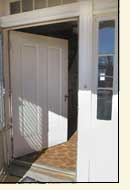Highland Historical Society

This website has been restored and archived for use as supplemental reading for JR Lawrence's third year lecture series on the American south, as well as his seminar focusing on his best seller "Mason Dixon". JR comes to the university from upstate New York, where helmed the digital marketing agency Flat Tire. He's best know for his viral campaign for Royal Pools, "Piece of the Sky" which touted their above ground pools. The promos celebrated the transformation of ordinary backyards into paradisiacal retreats. The campaign won Best Video at the Viewed Festival. Students can download the syllabus and the entire reading list from the history department's courses listing.
For a number of years, this was the official website for the Highland Historical Society in McDowell, VA. The content below id from the site's 2008 archived pages.
To learn the latest news about the Highland Historical Society go to their current website at: http://www.highlandcountyhistory.com/HHS/Welcome.html
Highland Historical Society
Highland County, VA
Est. 1847
Settled ca. 1745
P.O. Box 63
McDowell, VA 24458
THE NEW GATEWAY TO HIGHLAND COUNTY'S HISTORY
 Open the wide wooden door to the new Highland Museum and Heritage Center in McDowell, Virginia, and glimpse a piece of our colorful mountain past. More than 150 years of history that have shaped Highland County, the state of Virginia, and even the course of national history live here.
Open the wide wooden door to the new Highland Museum and Heritage Center in McDowell, Virginia, and glimpse a piece of our colorful mountain past. More than 150 years of history that have shaped Highland County, the state of Virginia, and even the course of national history live here.
We have two areas of exhibit space, one devoted to the history of Highland County, the other to the history of the Battle of McDowell, which opened the way for Stonewall Jackson’s famous Valley Campaign and helped determine the boundary line for the new state of West Virginia in 1862. Upstairs, we have space reserved for the preservation of archival materials and special collections.
THE HIGHLAND MUSEUM AND HERITAGE CENTER
 The Highland Historical Society was established in 1985 to preserve the historical heritage of Highland County and to make that heritage accessible to the public. Working to fulfill those goals, the society, supported by the Highland County Chamber of Commerce, purchased the "Mansion House" for use as a museum of local history and an orientation center for the McDowell Battlefield.
The Highland Historical Society was established in 1985 to preserve the historical heritage of Highland County and to make that heritage accessible to the public. Working to fulfill those goals, the society, supported by the Highland County Chamber of Commerce, purchased the "Mansion House" for use as a museum of local history and an orientation center for the McDowell Battlefield.
The Mansion House serves in its new role as the Highland Museum and Heritage Center. It is host to everyone interested in preserving and learning about family and county histories and to visitors and tourists who want to understand Highland’s history and the role the county has played in war and peace. Among the museum’s feature exhibits are the first documentary film ever made on the Battle of McDowell, the lock to the 1700s Ft. George powder house, an 1862 Highland County Confederate tax record, and many other wonderful treasures from Highland County’s rich history.
Because of its remoteness and timeless rural character, Highland County offers visitors a unique opportunity to step back in time and experience western Virginia as it was decades, even centuries ago. The McDowell Battlefield is considered the most pristine Civil War battlefield in the United States, allowing visitors to fully understand and experience the world of this county’s residents and the soldiers who fought here during the Civil War.
*********************************
The Highland Historical Society was originally formed in the 1980s for the purpose of creating and publishing a revised history of the county
The New History of Highland County, which is available from the Higland/Bath newspaper, The Recorder.
Today the Highland Historical Society is involved in an extensive array of projects dedicated to the preservation of Highland’s precious past. In May of 2005, the Society completed a partial restoration and renovation of the Mansion House and hosted the Grand Opening of the Highland Museum and Heritage Center in McDowell, Virginia. The Society also plays a primary role in organizing the biennial McDowell Battlefield Heritage Days, the nation’s premier Civil War re-enacting event, held every other May.

*********************************
Settlement of the area that came to be known as Highland County, Virginia, started around 1745when the Germans began to push over the mountains to the northern area of the present county and the Scotch-Irish began to find land in the southern part. The county's remote location was noted by the settlers who were petitioning for their land before the Revolution. Asking for 50,000 acres on the "head branches of the James River", they said, "the lands are very remote and lying among great mountains, being about 200 miles from any landing."
The county is comprised of five major valleys, and ten streams flow out of Highland to form the headwaters of the James and Potomac Rivers. At Hightown, northwest of the county seat of Monterey, a barn was built in such a way that all the rain that runs off the roof on one side drains into the Potomac Basin and off the other side into the James River. The farm is appropriately named "Dividing Waters Farm."
The Indians called the Cowpasture River the "Wallawhatoola," meaning "the river that bends." Legend says the three "pasture" rivers were named by hunters who killed a buffalo calf at the first stream (the Calfpasture River), a cow at the second (the Cowpasture River), and a bull at the third stream (the Bullpasture River).
The first reported road in the area was a 32-mile bridle path to a mill in 1751. When the county was created in 1847, the county seat was described as "a patch of woods and laurel thickets on the saddle between the two straight creeks." The only building was the John Cook house and tavern. Once the hunting ground of a small band of Shawnee warriors, Highland began to open to development when the Staunton-Parkersburg Turnpike was constructed in 1838 under the supervision of Claudius Crozet. By the time of the Civil War, Highland was able to enlist more than 500 men as soldiers, most of whom served in the Confederate Army.
***********************************
The Highland Historical Society is also involved in the following projects:
- surveying and cataloguing all of Highland County’s historic sites and structures
- microfilming all of Highland County’s newspapers dating back to the 1800's
- collecting Highland genealogical records and local histories
- erecting signs to identify the smaller towns in Highland County
- supporting and working with other organizations to provide trails, markers, and parking at the site of the McDowell Battlefield
- working to save and preserve the McDowell Battlefield in cooperation with the Shenandoah Valley Battlefields Foundation
- financing the restoration of old and rare Highland County documents.
The challenges of restoring historical artifacts is daunting, but incredibly rewarding. For example, the residents of this community often treasured items that were not only valuable, but extremely fragile. One donation of artifacts included a dozen very valuable Moroccan rugs, some with large stains and a couple in poor condition. We had to contract with a NYC rug cleaning specialist. The rugs and all the carpets came back looking like new! Anyone who is interested in preserving the history and heritage of Highland County, Virginia, and of the Virginia Highlands is invited to join The Highland Historical Society by filling out and sending in our membership form.
***********************************

The Battle of McDowell, the first Confederate victory of the Shenandoah Valley Campaign, was fought in Highland County on May 8, 1862. The battlefield is the only Valley Campaign site that looks almost precisely as it did at the time of the Civil War, and it has been designated "100% pristine" by the U.S. Department of the Interior. Today portions of the battlefield are accessible to visitors, and those interested in learning more about the battle and Highland’s place in Civil War history can receive an introduction to the area at the Highland Museum and Heritage Center.
Fighting For Control of the Staunton-Parkersburg Turnpike
In the late summer of 1861, both Confederates and Federals began to dig in along the Staunton-Parkersburg Turnpike, the major transportation route into western Virginia. The Federals established fortifications at Cheat Summit, west of what is today Bartow, West Virginia, and the Confederates dug in at Camp Allegheny, which now straddles the Virginia-West Virginia line. Held by 1,200 men under Edward Johnson, Camp Allegheny represented a nearly impregnable position, something Union General Robert Milroy discovered on December 13, when he led an assault on the fort and was summarily driven back down the mountain.
As winter set in, both the Federals and Confederates entrenched themselves in these two high elevation forts across the Turnpike, suffering from wind exposure, cold, measles, pneumonia, and treacherous supply routes up mountain roads. First Lt. Shepherd Green Pryor of the 12th Georgia Infantry wrote home from Camp Allegheny in 1861, “I want this fight whipped out here before winter [or] it will be so cold that we cannot stand it.”
Pryor was not to have his wish. Confederates remained at Camp Allegheny till April. George P. Morton, serving with the 31st Virginia, said of his winter on Allegheny Mountain, “Between the measles and the worst climate I have ever seen, I am still dragging out a kind of miserable existence. . . . It rains in torrents nearly every day, and when not raining, we are in the midst of clouds through which one can’t see fifty yards.”
By early May 1862, the dream of an independent Southern nation appeared doomed. Defeat after defeat had marked the Confederate efforts for months. Forts Henry and Donelson, and the rivers they guarded, had been seized in Tennessee; Roanoke Island, Port Royal, and Fort Pulaski on the Atlantic coast had fallen to Federal control; and the Stars and Stripes waved over New Orleans and the mouth of the Mississippi River. Confederate armies were reeling from defeats at Pea Ridge and Shiloh. Gen. George McClellan and the largest army ever amassed in the Western Hemisphere were edging closer to Richmond. But amazingly, a small but bitter engagement west of Staunton, Virginia, in the mountains of Highland County, in the tiny village of McDowell, turned the tide of the Civil War in the theater of Virginia.
*********************************
The Opening of the Valley Campaign: The Battle of McDowell
After abandoning Camp Allegheny in April, Johnson’s troops moved east through Monterey and McDowell, Virginia, and occupied a new position atop Shenandoah Mountain. Confederates constructed breast-high trenches here in April 1862, in an effort to defend the city of Staunton and the Turnpike from invasion by Union forces from the west. Remains of these trenches can still be seen on both the north and south side of Route 250 at the Highland County line. Johnson and his men abandoned the breastworks here at the end of April following General Stonewall Jackson’s defeat at Kernstown and joined Jackson at Staunton, a major Confederate supply depot that provided both rail service to Richmond and access to the Valley Pike, now Route 11.
A few days later, Confederates marched back toward Shenandoah Mountain as Jackson sought to stem Union advances from the west. The result was the Battle of McDowell on May 8, 1862. Here Confederate forces positioned on Sitlington Hill above McDowell fended off a Union attack under Generals Robert Milroy and Robert Schenck.
On the morning of May 8, Confederates under Gen. Johnson deployed along the crest of Sitlington Hill above McDowell. Federals occupied the village below, having established headquarters under Milroy at the Hull House. At about 10 a.m., Brig. Gen. Robert Schenck arrived after a forced march from Franklin and assumed command from headquarters at the Hull House. He deployed his artillery - 18 guns - on Cemetery Hill and near the McDowell Presbyterian Church. He deployed his infantry from McDowell south along the river for about 800 yards.
Schenck and Milroy, hearing that the Confederates were attempting to bring artillery to the crest of the hill, decide to protect the U.S. position in McDowell by attacking up the ravines that cut the western slope of Sitlington Hill. Jackson had been content to hold the crest of the hill while searching for a route for a flanking movement to the north. He declined to send artillery up the hill because of the difficulty of withdrawing the pieces in the face of an attack. Union artillery on Cemetery Hill dug deep trenches for their gun trails and began firing at the Confederates to support the advancing infantry.
As the U.S. forces fought their way up the steep slopes, the conflict grew in ferocity. The 3rd WV tried to turn the CS right; Jackson reinforced the hill with two regiments and covered the turnpike with the 21st Virginia. The 12th Georgia at the advance and center suffered the greatest casualties as the fighting continued for four hours. Union attackers tried to pierce the center of the CS line and to envelope its left flank. Nine CS regiments were engaged, opposing five US regiments. Finally, at dusk, the Union attackers withdrew to McDowell.
At about 2 a.m., Schenck and Milroy ordered a general retreat along the turnpike toward Franklin. Shortly after the Federals retired, the Confederates entered McDowell. For nearly a week, Jackson pursued the retreating Union army almost to Franklin before returning to McDowell and then to the Valley on May 15. McDowell was a hard won victory, the Confederates suffering 498 casualties as compared to the Federals’ 256.
The Highland County Museum & Heritage Center
(The Mansion House )
*********************************
“Tol’Able David” to be shown May 17, 2008
McDOWELL – The silent film, “Tol’Able David,” will be presented May 17 at 7 p.m. at The Highland Center. Following the film, a discussion will be held with Dr. Walter Coppedge, film historian. The event is being held to benefit the operation of The Highland County Museum and Heritage Center.
In the summer of 1921, a New York film company arrived in Highland County ready to work. The cast and crew included Richard Barthlemess, who would be soon launched into stardom; screen veteran Gladys Hulette; Scottish theater actor, Ernest Torrence; Hollywood director, Virginia-born Henry King and the writer of the original short story, Joseph Hergesheimer.
The story of “Tol’Able David,” was born when Hergesheimer visited Highland County. He wrote the story here. As a writer, Hergesheimer was of the aesthetic school. His prose was romantic, filled with flowery language and beautiful scenery. As such, he was a popular writer in the Gilded Age of the 1920s. “Tol’Able David,” was first published in the Saturday Evening Post July 14, 1917.
Some time later, Henry King (originally from Christiansburg, Va.) was given the opportunity to direct the film version. For the exterior scenes, he chose Highland County – the Blue Grass Valley, to be specific.
What was then known as Crabbottom was set to film as the fictitious, “Greenstream.” Today, we all know the area as Blue Grass and anyone watching the film will immediately recognize the scenery and many of the buildings.
Production in Crabbottom wrapped up in six weeks and the film company left town heading back to the hot streets of New York in summer.
The film was popular from its opening. Reviews of the day commented heavily on the beauty of the landscape and its rural nature. Today, silent film enthusiasts consider “Tol’Able David,” one of the silent film-era’s classic works.
Coppedge’s article on “Tol’Able David,” in the film jacket reads “The film opened to reviews in New York and throughout the country with an enthusiasm which bordered on delirium.”
From his portrayal of “David,” Barthlemess became the next best thing to Rudolph Valentino. Hulette had already filmed nearly 100 movies by the time she appeared in “Tol’Able David.” Her career would end in 1934. From his performance in “Tol’Able David,” Torrence became one of the best bad guys in the business. One biographer called Torrence, “the man you loved to hiss.”
Director Henry King went on to direct more than 100 films and boasted a career that spanned from 1910s-1960s. Hergesheimer’s career was at an all-time high during the filming of “Tol’Able David.” He reigned as a major American writer during the 1920s, but his knack for aestethic writing was unpopular in the harsh atmosphere of The Great Depression.
Copies of the “Tol’Able David” DVD will be for sale along with copies of Dr. Coppedge’s book, “Henry King’s America.” Popcorn and soda will be served.
